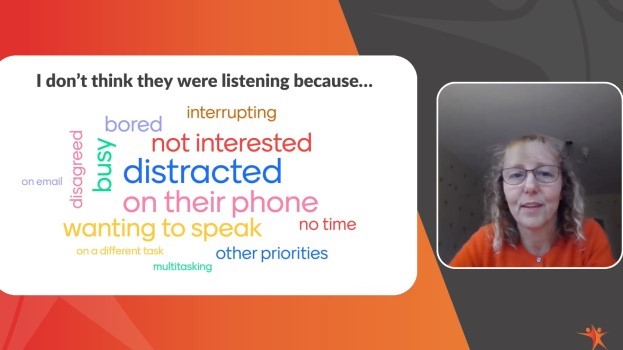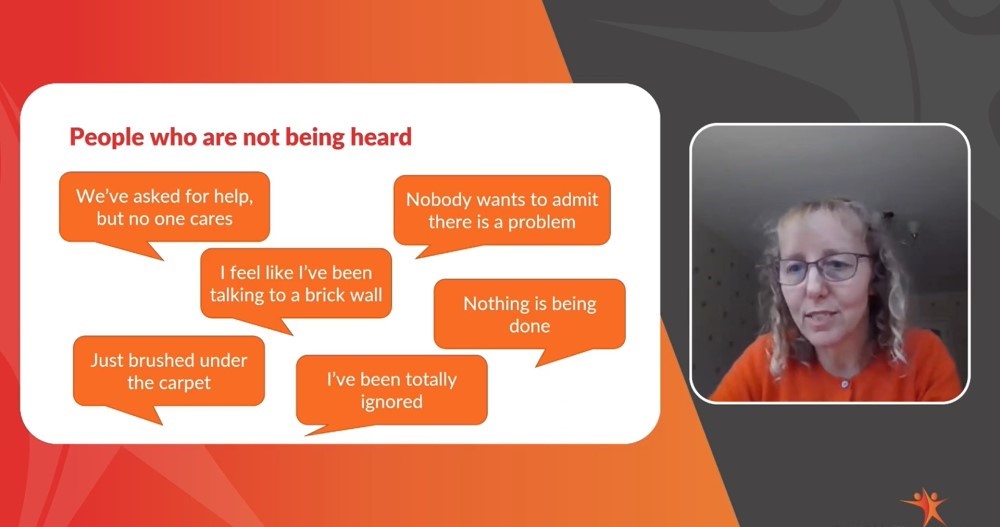What does listening well look like and how can it create a safer workplace where people can thrive? CIRAS’ Catherine Baker shared her thoughts at Rail Wellbeing Live in late 2023.
Closing the listening gap and listening effectively can create not just a safer workplace but also a culture where people can thrive and feel psychologically safe, improving wellbeing. Listening is also a crucial tool during times of uncertainty and change.
Did you know there’s a link between being properly heard and our sense of wellbeing? ‘The body mimics a pain response when someone does not feel heard,’ explained director of CIRAS Catherine Baker. ‘The opposite is also true – when someone does feel heard, there is a physiological reward response.’
There’s also a link between listening and psychological safety, and how this promotes a safer workplace.
‘Historically at CIRAS, we’ve spent a lot of our effort encouraging people to speak up and working alongside companies to help improve speaking-up cultures,’ Catherine said. ‘But increasingly I’m interested in the listeners, those who need to feel psychologically safe enough, and have the time and headspace, to actually listen to what is being raised when people speak up. Are we giving these people, people like yourselves, what you need to play your part in the process?’
Time, distractions, who is speaking… these are all potential barriers to being able to listen fully, and it gets harder if what is being said could be taken as criticism or challenge.

Above: 'At a previous event I asked people to think of a recent situation and share why they thought the other person was not listening to them – this is what they came up with.’
‘Many of us work in an environment where we are dependent on each other for our safety, and for the success of our day’s work,’ Catherine said, explaining that we have our own ‘rituals’ we all use to create an environment where everyone is looking out for others’ safety, and where everyone expects to listen and be listened to, for example through work site briefings and team calls.
‘So why, given that organisational safety cultures have improved so much, are people not always feeling listened to?’ The quotes below show how people don’t always feel heard.

Threat response
Put yourself in the role of listener. Imagine that someone has just told you that something you are responsible for is not working as planned. How does it make you feel?
You should be able to pick more than one answer.
- Curious
- Defensive
- Thankful
- Threatened
- Upset
- Something else
‘You could argue that in that moment, having to listen is a challenge for your own wellbeing. We don’t like to be told we’ve made a mistake, a poor decision, or overlooked something important,’ said Catherine, after explaining the role of threat response and the different levels of this. ‘It threatens our authority, our expertise. But how we handle it can make a huge difference to both our own wellbeing and that of the person raising feedback. As well as determining whether that feedback will ever be used.
‘In a psychologically safe environment, not only does everyone need to feel safe to speak up, but you need to feel safe enough to listen, to hear what is being said, without feeling threatened. The wider work context matters here.’
The real danger is when this sense of social threat means that we don’t listen.
Listening tips
To listen well, we need a little TNC:
T – Give yourself time to listen without jumping to a response.
N – Notice your own emotions, acknowledge them, but don’t let them act.
C – Be curious: ask questions to understand what’s being said, why it’s being said, and why now?
Once you have listened, get on the TRAIN to work through your response:
T – Thank the person for coming to you, recognising that this may have been a big deal for them.
R – Reflect and investigate: do you need input from others to really understand the issue?
A – Act, once you’ve got the full picture and can plan rationally.
I – Inform the person what action has been taken and why. This is a really important step to validate their courage in speaking up and demonstrate that it has had an impact.
N – Invite new input. Actively encourage them to share further concerns or ideas to build a culture of openness and learning.
If someone has come to you with a health or safety concern and you have really listened, you are well on the way to overcoming safety silence.
The harm of safety silence
Safety silence lies behind many harmful events. Catherine delved into some examples of this in her talk, including the story of Dr Alice Stewart, a pioneering doctor and scientist who was the first to identify a link between neonatal X-rays and childhood Leukaemia in the 1950s. Although published in 1958, it took several larger studies by other research teams, and another 25 years before the medical establishment listened and stopped X-raying pregnant women.
Agile listening
Many of us know someone who is an agile speaker, able to speak from the perspective of many types of people. But how many of us are agile listeners? Four different people might raise the same issue in four completely different ways, Catherine said, giving examples.:
- Outspoken Ashley might come up to you and say straight out, 'The gate is broken.'
- New recruit Sam might ask, 'Is the gate always tricky to lock?'
- Contractor Charlie might say, 'Sorry I’m late. I had some trouble with the gate.'
- Pat says nothing, just fetches a plaster from the first aid box to patch up a finger that got trapped in the gate.
What do you hear in each of those cases?
'Spend a few minutes thinking about the people you work with – for example, the different backgrounds and cultures they’re from, the different characters, the range of experiences, whether they are on secure employment contracts, or how senior they are. All of these are likely to affect not only whether they will raise an issue but also when, where and how they do so, and how likely you are to listen. Who do you tend to hear from already? More importantly, who don’t you hear from?
'Going right back to the start and those work-based rituals... Are yours truly inclusive? Does everybody participate, or do some stand quietly in the shadows? If so, please don’t ignore this – building a culture where we can all tune in to each other not only makes us feel good – it makes us safer too.'
Watch the full talk by Catherine on-demand on the Rail Wellbeing Live website
Find out more
Listening well can improve outcomes in times of change
Listening inclusively: check your own bias
Safety voice: what causes people to stay silent? And what can we do about it?
Why listening can prevent safety silence
Who's listening? If you're not being heard, you have choices
